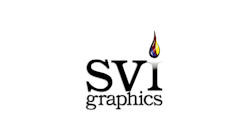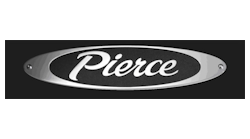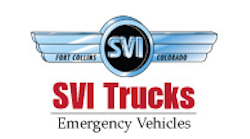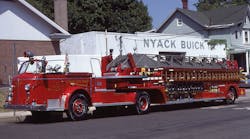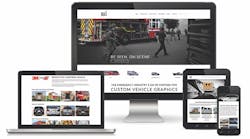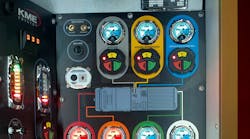When one thinks of a fire apparatus, the iconic image is a shiny red engine with a finish that gleams like a mirror and stunning lettering and graphics. It’s always been that way. It’s tradition.
That legacy continues today with some variations and twists on the theme as apparatus manufacturers provide dazzling finishes with some added enhancements that only technology can provide. Computers can now generate virtually any image firefighters can think of and translate them into decals for application on apparatus.
“It’s unbelievable the kind of graphics packages departments come up with these days,” said Chad Parker, a graphic applicator for Pierce Manufacturing, based in Appleton, WI. “It’s like they try to outdo each other with crazy cool graphics.”
Parker said there’s nothing Pierce can’t do when it comes to graphics. Original artwork or photos and images can be scanned into electronic formats and sized to fit the apparatus. Then, the image is printed onto high-quality vinyl decal material with a large-format inkjet printer. The decals are then applied to the apparatus by the graphics team.
Original Artwork
Mike Grabner, a colleague of Parker at Pierce, is a graphics technician who paints original art and images for departments for use on apparatus. There was a time when he would hand-paint the mural, scene or image on the apparatus, which was time-consuming and expensive, especially if the image appeared in more than one spot on the vehicle. Typically, images will appear on both sides of the apparatus, meaning double the work.
Now, Grabner said, he can paint an original image on material and then scan it optically and print it. And, because the image is digital, he can make two images at the press of a button, and even make a mirror image for the opposite side of the truck, if necessary.
Grabner once painted an image of the Headless Horseman for Sleepy Hollow, NY, for use on its new Pierce apparatus.Parker bragged on his colleague, saying it was “awesome.” Grabner said he still has the original that was scanned for use on the apparatus.
Scott Oyen, CEO of Rosenbauer America, in Lyons, SD, said that while some of the graphics can be very imaginative, there are many that are popular with virtually every department.
“American and Canadian flags are very popular,” Oyen said. “… if a computer can print the design, we can install it.”
SVI Graphics Manager Amy Bernhardt said that even gold leaf can be printed on vinyl. SVI Graphics is a division of SVI Trucks, based in Fort Collins, CO, doing graphics for fire departments nationwide.
“Gold leaf seems to be more popular on the East Coast, but even then, we’re seeing more departments opt for graphics printed on traditional vinyl,” Bernhardt said.
Bernhardt added that SVI has mastered printing directly on gold leaf, which is not an industry-standard capability.
“With this new technique, we no longer have to layer materials, which creates a seamless look and enhances the longevity of the product,” she said.
Printing on Gold Leaf
Bernhardt said SVI Graphics are now able to print on 22K gold, which provides an iconic look, with more accuracy.
“We’re also able to layer the 22K gold over reflective vinyl, which adds reflectivity to help keep crews safe,” she said.
There’s also a product called Super Gold, which Bernhardt described as essentially fake gold that creates a similar look at an economical price.
“We’re definitely seeing more customers opting for Super Gold lettering,” Bernhardt.
Some manufacturers, like Rosenbauer, have gone straight to vinyl.
“The last time a truck was hand-lettered here in South Dakota was in the mid-1990s when vinyl came on the scene,” Oyen said. “Some customers do have their apparatus hand-lettered, however, that is done back home.”
Pierce still offers hand-applied gold leaf at the factory, doing as many as five annually, Grabner said.
“It’s a dying art,” Grabner said of hand-applied gold leaf. Pierce, he said, uses between five and 10 ounces of gold, hammered into thin sheets, annually. The material is available in 23K gold, white gold and an 18K lemon gold to offer customers more variety, he said.
The expense is a huge threshold for most departments that choose alternatives to real gold leaf, but maintenance is another, Grabner said.
Real gold leaf requires application of clear coat every six months to maintain the appearance, Grabner said, adding that as an option. Pierce offers a proprietary vinyl gold leaf called Goldstar.
“Seventy percent of the 1,700 units we build annually use Goldstar,” he said. “It’s bulletproof.” He added that it is durable and doesn’t fade like paint.
Paint Finish
Before any graphics are applied, there has to be a good base—the finish of the apparatus.
To make sure there’s a proper finish, Parker said Pierce uses an epoxy paint that doesn’t off-gas volatile organic compounds (VOC) as paint cures. Parker explained that trapped gas under the decals and graphics can cause bubbling and distort images and lettering.
A lot goes into making apparatus paint finishes which have a deep, rich look as if one could stick their hands in the color and swirl it around.
SVI Trucks Paint Manager Chris Woellhof said SVI uses a commercial coating system made by PPG called Delfleet Evolution.
“SVI Trucks relies on PPG’s fleet coating technology because we found it to be more resistant to the harsh environments our trucks will encounter,” Woellhof said. “We’re starting to see more companies use it because of its durability.” He added that SVI Trucks have a 10-year warranty on paint.
“It’s important to read the fine print,” Woellhof said. “You’ll want to watch for exclusion because those limitations can quickly make a warranty null-and-void.”
In addition to durability, Woellhof said Delfleet Evolution products are available in 3,600 metallic and solid colors.
“PPG offers a whole color deck just for fire and emergency,” Woellhof said.
Parker, Pierce’s paint person in the graphic’s department, said Pierce has about 800 paint codes on file for fire apparatus.
Parker and Grabner said Pierce has painted apparatus a variety of colors, including purple and lavender, metallic green and even the colors of the Tampa Bay Buccaneers—Rosso Corsa, Ash Gray, Smoky Black and Heat Wave.New Finish Trend
For Rosenbauer, the latest trend in finishes for apparatus is not paint.
“LINE-X is by far the most popular ‘new trend,’” Oyen said. “It’s very popular for our ‘blackout trim package.’”Oyen said Rosenbauer also offers vinyl 3M vehicle wrap, which, while not widely used, offers different textures which are not available in traditional paint coatings.
“Our first off-the-line Avenger was wrapped with 3M,” Oyen said.
While it is not quite a wrap, SVI Trucks installs rear chevrons as one-piece panels, Bernhardt said. She further explained that a one-piece panel installation ensures the proper 45-degree angle and eliminates seams that can erode graphics.“When you’re shopping for a graphic vendor, make sure you contact one that understands the angle, color, direction and thickness of chevron striping to ensure your department meets National Fire Protection Association (NFPA) standards,” Bernhardt said.
Pierce has four full-time people dedicated to installing chevrons, Parker said.
“It’s a very big process,” Parker said. He commented that creativity carries over to the rear of the apparatus, too, with customers asking for the safety chevrons to depict flags and red, white and blue configurations.
That flag motif also shows up on the front of the apparatus, with some customers electing to have numbers or images painted on the wire mesh found on the front of apparatus.
“We have one lady and that’s all she does is paint numbers on the grills,” Parker said, adding that it’s fairly tedious work, but the employee loves the gig.
Bigger Budgets
Parker pointed out that when he joined Pierce in 1994, there wasn’t much to graphics packages for fire apparatus.
“There was pretty much a 10-inch white strip down the sides and gold leaf on the doors,” he said.
Grabner said that today fire departments can spend from $2,000 to $20,000 just for graphics.
“And with a budget of $20,000, there’s not much you can’t get,” he said.

